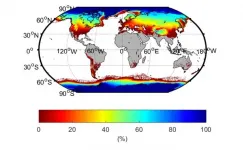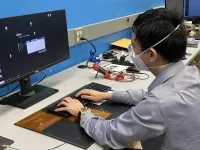(Press-News.org) Several cancer tumors grow through immunosuppression; that is, they manipulate biological systems in their microenvironments and signal to a specific set of immune cells--those that clear out aberrant cells--to stop acting. It is no wonder that immunotherapy designed to re-establish anti-tumor immunity is rapidly becoming the treatment of choice for these cancers.
One natural immunosuppressive molecule that falls prey to helping cancer tumors is indoleamine-2,3-dioxygenase 1 (henceforth, IDO1). Because it is found in a broad range of cancer tumors, including those of the skin, breast, colon, lung, and blood, scientists have begun to see it as a promising therapeutic target: Suppress its activity and anti-tumor immunity should be back. But all endeavors so far have failed in phase 3 clinical trials--the stage at which a large number of people with the disease try out the optimal dose to test its true efficacy. Why is something so promising in theory and in the lab fizzling out in late phase clinical trials?
To find out, a team of researchers, led by Dr. Ming-Rong Zhang, Director of the Department of Advanced Nuclear Medicine Sciences at the National Institutes for Quantum and Radiological Science and Technology, Japan, tried positron emission tomography (PET) imaging to track IDO1 activity after a possible treatment has been administered. What they found is a breakthrough now published in BMJ's Journal for ImmunoTherapy of Cancer.
"In our paper, we highlight the development cycle of our PET imaging method, starting from tracer synthesis and biomarker identification to biomarker validation in a mouse model of melanoma treated with different immunotherapy regimens," says Dr. Zhang.
The team of scientists began with a radiotracer--chemicals that emit radiation which can then be detected by machines--that is known to bind to IDO1. After establishing that this radiotracer can reliably reflect levels of IDO1 expression at specific sites in the body, they proceeded to find out whether it can also reflect the varied treatment outcomes of three combinatory immunotherapy strategies, each involving an IDO1 inhibitor.
They administered the radiotracer and the therapies to mice with a cancerous tumor and watched what happened over time through whole-body PET imaging. To their surprise, despite one of the treatment strategies clearly having greater efficacy than the others--wherein, IDO1 was inhibited much more than in the others--the radiotracer uptake in the tumors seemed to be the same across all treatments. However, in the case of this standout treatment strategy, the radiotracer signal beamed in an off-tumor organ called the mesenteric lymph node. This was not the case for the other two treatment strategies. Further probing confirmed that in these lymph nodes as well, the radiotracer bound to IDO1. But why this organ? That is research for another study.
In this study, the scientists went on to explore one more checkpoint: did the peak and trough of this radiotracer in the lymph nodes mirror those of maximum tumor inhibition and decline of treatment effect? Turns out the radiotracer uptake increased from a few days before the peak, peaked with peak treatment efficacy, plateaued until a few days before treatment decline began, and fizzled out when the tumor relapsed.
So, the scientists had stumbled upon an unprecedented new biomarker with which IDO1 activity could be monitored non-invasively, a really promising alternative to the invasive biopsy.
Further explaining the results of the study, Dr. Lin Xie, co-author of the paper says, "Our findings imply that the IDO1 status in the mesenteric lymph node is an unprecedented surrogate marker of the cancer-immune set point, which is an equilibrium state from tumor tolerance to elimination, in response to immunotherapeutic intervention."
Dr. Kuan Hu, another researcher involved in the study, says, "Our study holds great potential as a robust method for visualizing personalized antitumor responses in patients, to address the possible causes for the failure of the existing clinical trials, thereby improving the therapeutic outcome of IDO1 regimens. Our research also illustrates a potential precision medicine paradigm for noninvasive visualization of each patient's individual response in combinatorial cancer immunotherapy and opens up new avenues for future clinical trials for precision anti-cancer immunotherapies."
INFORMATION:
Research Article:
"Off-tumor IDO1 target engagements determine the cancer-immune set point and predict the immunotherapeutic efficacy"
Lin Xie, Kuan Hu, Yanhong Duo, Takashi Shimokawa, Katushi Kumata, Yiding Zhang, Cuiping Jiang, Lulu Zhang, Nobuyuki Nengaki, Hidekatsu Wakizaka, Yihai Cao and Ming-Rong Zhang
Journal of ImmunoTherapy of Cancer: June 20, 2021, DOI:
http://dx.doi.org/10.1136/jitc-2021-002616
About National Institutes for Quantum and Radiological Science and Technology:
The National Institutes for Quantum and Radiological Science and Technology (QST) was established in April 2016 to promote quantum science and technology in a comprehensive and integrated manner. QST's mission is to raise the level of quantum and radiological sciences and technologies through its commitment to research and development into quantum science and technology, the effect of radiation on humans, radiation emergency medicine, and the medical use of radiation. To ensure that research and development delivers significant academic, social and economic impacts, and to maximize benefits from global innovation, QST is striving to establish world-leading research and development platforms and explore new fields.
Website: https://www.qst.go.jp/site/qst-english/
About Dr. Ming-Rong Zhang from National Institutes for Quantum and Radiological Science and Technology, Japan:
Dr. Ming-Rong Zhang currently serves as the Director of the Department of Advanced Nuclear Medicine Sciences, Institute for Quantum Medical Science at the National Institutes for Quantum and Radiological Science and Technology. He is an expert in the fields of PET chemistry and molecular imaging and his expertise is demonstrated in over 300 studies in these fields, published in reputed international and national journals. Currently, part of his research endeavors focus on improving the detection of immunosuppressive tumors.
Funding information:
This study was funded by JSPS KAKENHI (Grant Nos. 20H03635), JSPS International Joint Research Program (Grant No. JPJSBP120207203) and the Initiative for Realizing Diversity in the Research Environment.
Media contact:
Public Relations Section
Department of Management and Planning, QST
Tel: +81-43-206-3026 Email: info@qst.go.jp
Researchers at the Francis Crick Institute and University of Dundee have screened thousands of drug and chemical molecules and identified a range of potential antivirals that could be developed into new treatments for COVID-19 or in preparation for future coronavirus outbreaks.
While COVID-19 vaccines are being rolled out, there are still few drug options that can be used to treat patients with the virus, to reduce symptoms and speed up recovery time. These treatments are especially important for groups where the vaccines are less effective, such as some patients with blood cancers.
In a series of seven papers, published today (2 July) in the Biochemical Journal, the scientists ...
Minority-ethnic medical students must have more role-models in senior leadership positions if they are to engage with academia. This is one of the conclusions drawn by a group of medical students writing in the Journal of the Royal Society of Medicine about the drivers and barriers to engaging with academia.
Barriers currently hampering the chances of minority-ethnic medical students accessing formal pathways into academia, they write, include differential attainment and unconscious bias, difficulties forming meaningful mentor-mentee relationships, as well as the ...
While autistic individuals are less likely to use substances, those who do so are more likely to self-medicate for their mental health symptoms, according to new research from the University of Cambridge and published today in The Lancet Psychiatry.
There is significant debate about substance use of autistic adolescents and adults. Some studies indicate that autistic individuals are less likely to use substances, whereas others suggest that autistic individuals are at greater risk of substance misuse or abuse. The team at the Autism Research Centre in Cambridge used a 'mixed methods' design to consider ...
In an article appearing in Nature Biomedical Engineering, a team of scientists from the UCLA David Geffen School of Medicine and UCLA School of Engineering report real-world results on SwabSeq, a high-throughput testing platform that uses sequencing to test thousands of samples at a time to detect COVID-19. They were able to perform more than 80,000 tests in less than two months, with the test showing extremely high sensitivity and specificity.
SwabSeq uses sample-specific molecular barcodes to simultaneously analyze thousands of samples for the presence or absence of SARS-CoV-2, the virus that causes COVID-19. SwabSeq was granted FDA Emergency Use Authorization in October ...
Cash in on the kids' inheritance and spend up big on the retirement plans - that's the message coming from the University of South Australia as new research reveals that older people are keen to spend their well-earned savings, rather than passing them on to their kids.
And while it may seem like bad news for the younger generation, the research also confirms that the kids are just fine with this scenario, claiming that no one owes anyone anything.
The surprising findings are part of a new study that explores contemporary attitudes towards wealth ...
LA JOLLA, CA--Researchers at La Jolla Institute for Immunology (LJI) have found that T cells from people who have recovered from COVID-19 or received the Moderna or Pfizer-BioNTech vaccines are still able to recognize several concerning SARS-CoV-2 variants.
Their new study, published online on July 1, 2021 in Cell Reports Medicine, shows that both CD4+ "helper" T cells and CD8+ "killer" T cells can still recognize mutated forms of the virus. This reactivity is key to the body's complex immune response to the virus, which allows the body to kill infected cells and stop severe infections.
"This study suggests that the impact of mutations ...
WASHINGTON--The global cryosphere--all of the areas with frozen water on Earth--shrank by about 87,000 square kilometers (about 33,000 square miles), a area about the size of Lake Superior, per year on average, between 1979 and 2016 as a result of climate change, according to a new study. This research is the first to make a global estimate of the surface area of the Earth covered by sea ice, snow cover and frozen ground.
The extent of land covered by frozen water is just as important as its mass because the bright white surface reflects sunlight so effectively, cooling the planet. Changes in the size or location of ice and snow can alter air temperatures, change the sea level and even affect ocean currents worldwide.
The new study is published in Earth's ...
People lived without plastic until the last century or so, but most of us would find it hard to imagine how.
Plastics now are everywhere in our lives, providing low-cost convenience and other benefits in countless applications. They can be shaped to almost any task, from wispy films to squishy children's toys and hard-core components. They have shown themselves vital in medicine and have been pivotal in the global effort to slow the spread of the COVID-19 pandemic over the past 16 months.
Plastics seem indispensable these days.
Unfortunately for the long-term, they are also nearly indestructible. Our planet now bears the weight of more than seven billion tons ...
As smart watches are increasingly able to monitor the vital signs of health, including what's going on when we sleep, a problem has emerged: those wearable, wireless devices are often disconnected from our body overnight, being charged at the bedside.
"Quality of sleep and its patterns contain a lot of important information about patients' health conditions," says Sunghoon Ivan Lee, assistant professor in the University of Massachusetts Amherst College of Information and Computer Sciences and director of the Advanced Human Health Analytics Laboratory.
But that information can't be tracked on smartwatches if the wearable devices are ...
Over years of studying antibody responses against the flu in the Wilson lab at the University of Chicago, researchers kept coming up with a strange finding: antibodies that seemed to bind not only to the flu virus, but to every virus the lab could throw at them. Since antibodies are usually highly specific to individual pathogens, in order to maximize their targeted protective response, this pattern was extremely unusual.
Until finally, they realized: The antibodies weren't responding to the viruses, but rather to something in the biological material in which the viruses had been grown. ...



